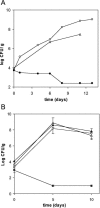Analysis of Pseudomonas putida KT2440 gene expression in the maize rhizosphere: in vivo [corrected] expression technology capture and identification of root-activated promoters
- PMID: 15937166
- PMCID: PMC1151710
- DOI: 10.1128/JB.187.12.4033-4041.2005
Analysis of Pseudomonas putida KT2440 gene expression in the maize rhizosphere: in vivo [corrected] expression technology capture and identification of root-activated promoters
Erratum in
- J Bacteriol. 2005 Aug;187(15):5504
Abstract
Pseudomonas putida KT2440, a paradigm organism in biodegradation and a good competitive colonizer of the maize rhizosphere, was the subject of studies undertaken to establish the genetic determinants important for its rhizospheric lifestyle. By using in vivo expression technology (IVET) to positively select single cell survival, we identified 28 rap genes (root-activated promoters) preferentially expressed in the maize rhizosphere. The IVET system had two components: a mutant affected in aspartate-beta-semialdehyde dehydrogenase (asd), which was unable to survive in the rhizosphere, and plasmid pOR1, which carries a promoter-less asd gene. pOR1-borne transcriptional fusions of the rap promoters to the essential gene asd, which were integrated into the chromosome at the original position of the corresponding rap gene, were active and allowed growth of the asd strain in the rhizosphere. The fact that five of the rap genes identified in the course of this work had been formerly characterized as being related to root colonization reinforced the IVET approach. Up to nine rap genes encoded proteins either of unknown function or that had been assigned an unspecific role based on conservation of the protein family domains. Rhizosphere-induced fusions included genes with probable functions in the cell envelope, chemotaxis and motility, transport, secretion, DNA metabolism and defense mechanism, regulation, energy metabolism, stress, detoxification, and protein synthesis.
Figures




Similar articles
-
In vivo gene expression of Pseudomonas putida KT2440 in the rhizosphere of different plants.Microb Biotechnol. 2013 May;6(3):307-13. doi: 10.1111/1751-7915.12037. Epub 2013 Feb 25. Microb Biotechnol. 2013. PMID: 23433036 Free PMC article.
-
Genomic analysis reveals the major driving forces of bacterial life in the rhizosphere.Genome Biol. 2007;8(9):R179. doi: 10.1186/gb-2007-8-9-r179. Genome Biol. 2007. PMID: 17784941 Free PMC article.
-
Role of iron and the TonB system in colonization of corn seeds and roots by Pseudomonas putida KT2440.Environ Microbiol. 2005 Mar;7(3):443-9. doi: 10.1111/j.1462-2920.2005.00720.x. Environ Microbiol. 2005. PMID: 15683404
-
Expression of a Pseudomonas putida aminotransferase involved in lysine catabolism is induced in the rhizosphere.Appl Environ Microbiol. 2001 Nov;67(11):5219-24. doi: 10.1128/AEM.67.11.5219-5224.2001. Appl Environ Microbiol. 2001. PMID: 11679348 Free PMC article.
-
Development and application of in vivo expression technology (IVET) for analysing microbial gene expression in complex environments.Infect Disord Drug Targets. 2006 Sep;6(3):207-40. doi: 10.2174/187152606778249944. Infect Disord Drug Targets. 2006. PMID: 16918484 Review.
Cited by
-
In vivo gene expression of Pseudomonas putida KT2440 in the rhizosphere of different plants.Microb Biotechnol. 2013 May;6(3):307-13. doi: 10.1111/1751-7915.12037. Epub 2013 Feb 25. Microb Biotechnol. 2013. PMID: 23433036 Free PMC article.
-
Disruption of the carA gene in Pseudomonas syringae results in reduced fitness and alters motility.BMC Microbiol. 2016 Aug 24;16(1):194. doi: 10.1186/s12866-016-0819-z. BMC Microbiol. 2016. PMID: 27558694 Free PMC article.
-
Polymyxin resistance of Pseudomonas aeruginosa phoQ mutants is dependent on additional two-component regulatory systems.Antimicrob Agents Chemother. 2013 May;57(5):2204-15. doi: 10.1128/AAC.02353-12. Epub 2013 Mar 4. Antimicrob Agents Chemother. 2013. PMID: 23459479 Free PMC article.
-
Rhizoremediation of lindane by root-colonizing Sphingomonas.Microb Biotechnol. 2008 Jan;1(1):87-93. doi: 10.1111/j.1751-7915.2007.00004.x. Microb Biotechnol. 2008. PMID: 21261825 Free PMC article.
-
What gets turned on in the rhizosphere?Microb Biotechnol. 2008 Sep;1(5):341-2. doi: 10.1111/j.1751-7915.2008.00054.x. Microb Biotechnol. 2008. PMID: 21261853 Free PMC article. No abstract available.
References
-
- Ausubel, F. M., R. Brent, R. E. Kingston, D. D. Moore, J. G. Seidman, J. A. Smith, and K. Struhl (ed.). 1987. Current protocols in molecular biology. John Wiley & Sons, New York, N.Y.
Publication types
MeSH terms
Substances
LinkOut - more resources
Full Text Sources
Other Literature Sources

